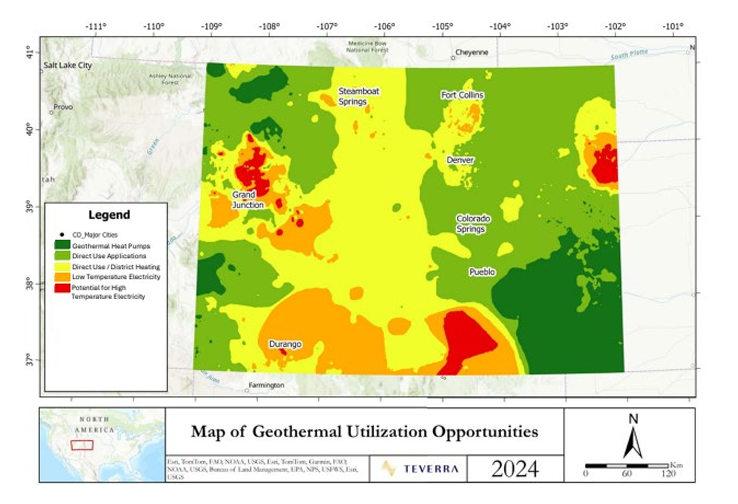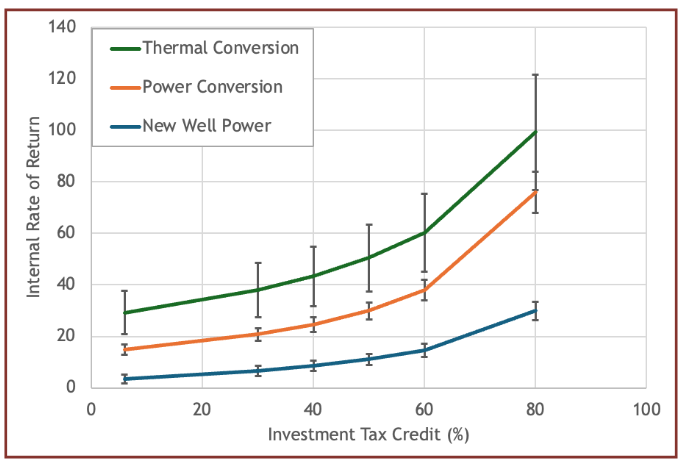The Colorado Energy and Carbon Management Commission (ECMC), the Colorado Geological Survey (CGS), and Teverra have published a comprehensive report on the geothermal resources and history of Colorado, a utilization and market analysis, and an environmental and regulatory evaluation of the state’s geothermal opportunities.
The full report, “Geothermal in Colorado: Resources, Use Strategies, and Impact Considerations,” can be accessed via this link. An Executive Summary is also available.
In early 2024, Teverra had been awarded a contract to conduct a comprehensive analysis of geothermal resources throughout Colorado. Since then, the Colorado Energy Office has announced funding of $7.7 million for 35 innovative geothermal projects, ranging from heat pump installations to geothermal power generation.
Multiple opportunities for geothermal in Colorado
One of the more important conclusions from the report is that Colorado can utilize multiple existing technologies to utilize its diverse geothermal temperatures. The report presents use cases for geothermal heat pumps, direct use heating, and binary and high temperature electricity generation.

Low to moderate temperature areas in the far NW Colorado, parts of SW Colorado along the Utah stateline, and most of eastern Colorado are prime candidates for direct use and thermal energy networks. On the other hand, geothermal electricity generation with binary power plant technology can be explored in areas such as the Upper Arkansas Valley, Raton Basin, Piceance Basin, San Juan Basin, and an eastern hot spot in Denver Basin.
In select areas of the state, there is potential for high temperature power production with deeper drilling that will likely become more technically and commercially available over time as technologies advance
Economic analysis of utilization models
The report also includes financial modeling of three development scenarios for geothermal electricity production:
- Establishing a new well field for geothermal electricity production;
- Converting existing wells into electricity producer; and
- Repurposing wells to generate hot water for industrial, commercial, or residential use.
The analysis encompassed four fundamental economic performance measures: net present value (NPV), internal rate of return (IRR), levelized cost of electricity or heat (LCOE or LCOH), and breakeven period. Over a 30-year project span, financial projections factored in development and operational costs, leasing expenses, taxes, discount rates, and investment tax credits.

Overall, the oil and gas well conversion for thermal energy option appears to be the most economical of the three cases
evaluated here. If multiple wells in a given area can be converted, there are also likely economies of scale that could improve the value of such a conversion process, both for electricity generation and for heat applications. Finally, for the new well case, more detailed evaluation of modern well drilling and completion techniques holds potential for improving the economic value of such an approach. Future improvements in geothermal systems and drilling/completion technology can potentially reduce the cost of those elements of the new well model.
Regulatory work is ongoing
The report also touched on several other topics such as the environmental risks associated with geothermal development and how these can be mitigated, as well as the current regulatory landscape for geothermal in Colorado.
On the topic of regulatory instruments, the Colorado ECMC is already collaborating on a study with the Division of Water Resources (DWR) to identify remaining issues that need to be addressed for the successful deployment of geothermal technologies in Colorado. This report will be publicly available by the 31st of December 2024.
Source: Colorado Energy and Carbon Management Commission
The post Colorado publishes detailed geothermal resource and utilization report first appeared on ThinkGeoEnergy – Geothermal Energy News.
